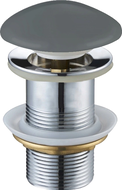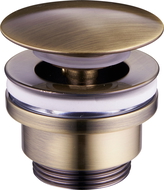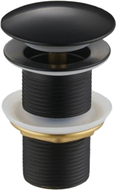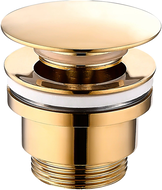
Sink, bathtub, kitchen sink. What do these plumbing fixtures have in common? It's that a plug is useful for their proper functioning. It allows for convenient filling and later emptying of used water. The main task of the plug is to block the water outflow, but to make full use of its capabilities, it should be cleaned regularly. How you should handle it depends on the way it's installed and the material it's made of.
Why do you need a sink plug?
While no one questions the necessity of a bathtub plug, some customers think about the sink plug and whether it is really needed. The dilemma seems trivial, especially if the sink is used solely for handwashing. However, if you want to close the drain and fill it with water, a plug, like a super-convenient click-clack plug, will surely be useful.
The sink plug fulfills the same function as a shower tray or bathtub plug, allowing the washbasin bowl to be filled with water, and then conveniently emptied. This way, for instance, you can do a small soak in the sink, or put plants in pots to wash them. The plug will protect the drain from debris that may appear in the sink in such a situation.
What types of plugs can you buy?
Every sink drain is secured with a strainer, which prevents debris from entering the siphon and then the sewage pipe, which could block it. The strainer is usually fixed, so when buying a sink plug, pay attention to its shape and size. The bathroom fittings market offers a wide range of diverse plugs, differing in operation or material. Generally, we can list:
- automatic plug,
- click-clack plug,
- brass plug,
- polypropylene plug.
Additional features may combine, resulting in:
- brass click-clack plug,
- chrome click-clack plug.
Nowadays, the click-clack plug is probably most commonly chosen when installing bathroom ceramics. It performs the same function as traditional plugs, blocking the water drain. How does the click-clack plug work? It's very simple – pressing the plug once causes the sink drain to close, and pressing it again raises the click-clack plug, allowing water to flow freely to the siphon. The mechanism the click-clack plug is equipped with does not require professional installation, you can handle it without a plumber.
How to clean a sink plug?
Whether your sink plug is used sporadically or is subjected to intensive use, regular cleaning is a must. Both brass and chrome or rubber plugs are subject to various contaminants. Most often, scale, soap residue, toothpaste, and other bathroom-used detergents accumulate on it. This affects not only its appearance but also its functioning. A layer of deposits on the edges of the plug may hinder the complete closing of the sink drain.
To clean a click-clack plug, you don't need any special products, home methods are sufficient. The simplest way is to remove the plug from the siphon and get rid of all dirt. Cleaning can be done with a strong stream of water, and for particularly stubborn deposits, an old toothbrush can be used. A brass plug can additionally be treated with a brass cleaning agent, which will give it a shine and further protect it from corrosion.
The click-clack plug should be cleaned regularly, preferably when cleaning the sink or when planning to clean the siphon. This ensures the process of closing and opening the sink drain runs smoothly. It's also worth using proven, traditional methods for a clean bathroom, like using vinegar. Just spray the plug with vinegar, give it a moment, and wipe it dry – vinegar effectively removes deposits!






















